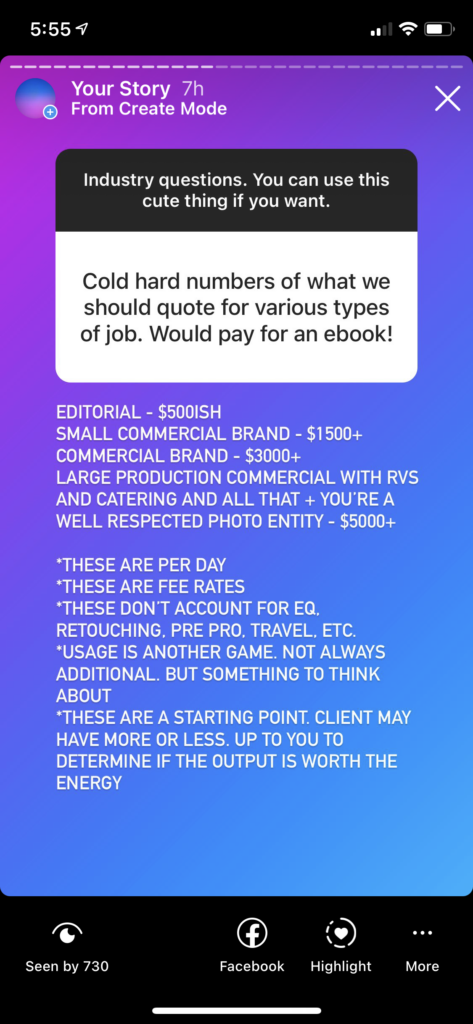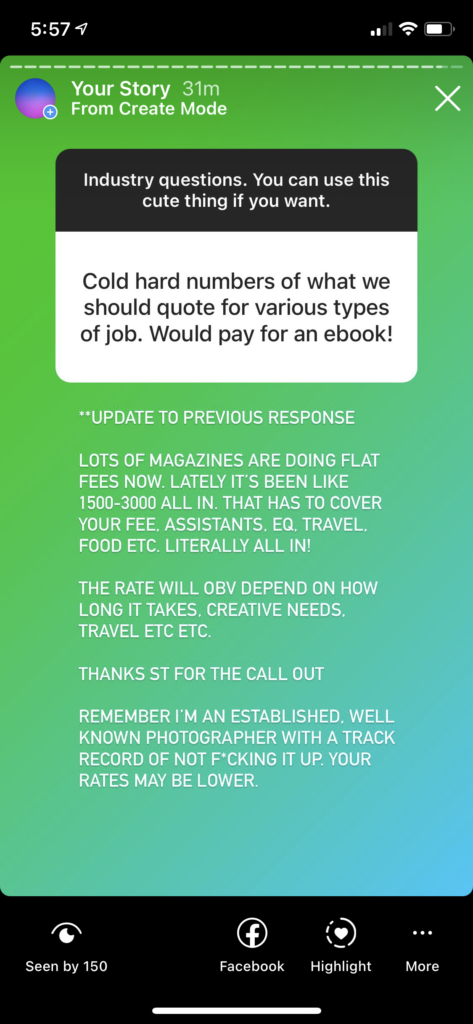Money
EG: Your creative fee should remain the same. Simply charge for the film costs and any other production costs associated with shooting film. The film is simply a production line item just like a c stand or catering. See this question for details.
Link to this anwser.
EG: First, let’s identify why I, personally, would want to shoot film on a job. For me, the combination of the cameras, the lenses, and the film ‘look’ create a certain picture quality that I still can’t really replicate with digital cameras. Also, I tend to shoot almost exclusively medium format film. Those cameras are slow and clumsy, so they force me to go into a mental zone that is hyper focused, methodical and way more intentional. I really enjoy that space and feel like the images are better, afterwards. Whether that’s true or not is 100% subjective, but that’s just how I feel. So if a job feels like it could yield some especially powerful imagery, I will try to shoot film if the logistics allow for it.
Everyone will have their own reasons for wanting to shoot film, and it’s important you identify why you’re even complicating things for yourself!
Once you identify that you’d like to shoot film for a certain project, now it’s time to get that approved by the client. Some clients will love the idea and embrace the added complications. For some clients/jobs, the answer will be ‘absolutely not.’ And maybe some jobs will allow for a hybrid shoot with some shots on film, but most on digital, or something like that. Every job will be different.
In order to get approval, you’ll most likely need to let the client know how much it costs and how much longer it will take to see images. This is really as straightforward as estimating how many rolls you will shoot, what that costs to buy/develop/print/scan and put that into an estimate. On bigger jobs, you may be able to add a little on top of those costs to cover the time to buy, run to lab, etc etc. Something like a 20% markup on top of the actual costs. For example, one roll of Kodak Portra 400 costs $10 to buy and $20 to develop and scan (medium res). If I anticipate shooting 10 rolls on a job, then it’s $30 x 10. You may need to add a high res scan on top of that or an actual c-print if that’s your process.
An example from an actual estimate below:
Example shows a 2-day shoot where I would rent two cameras and shoot an estimated 20 rolls of 120 per day @ $35/roll
Obviously, on a bigger shoot an added cost of $1900 is not that much. But for smaller shoots, it may be problematic.
Link to this anwser.
EG: We can’t answer questions this specific on FG, unfortunately. But we can provide some basic guidance for licensing questions, especially since they come up so often. I will say I see people doing this “the company is worth $XXX and they’re only offering $XXX” framework quite often. Remember that even though the company might be huge, they have many, many different tiers of marketing efforts and agencies they engage with. Sometimes the budget really is only $1000 because its some silly marketing push for them or you’re working through their below-the-line or social agency and budgets are REALLY small at that level.
I’m not proposing you accept what doesn’t feel right, but I just want you to consider that maybe $1000 is a lot of lattes for an image that is meaningless and gathering digital dust. Depending on what the project is, what kind of image we’re talking about, and exclusivity/usage, $1000 may be a fair price, tbh.
For a more in-depth answer to how to figure out licensing fees, we’ve answered that HERE.
CC: I actually don’t think $1000 is that bad and the reason is that it’s only being used on the internet. Usage is key here. A quick plug into the Getty calculator and I got $1,475 for worldwide digital media advertising usage. The calculator doesn’t have a perpetuity option but up to 3 years gives you an idea. Most brands will likely refresh their images in that span of time. Some people say to triple your 2-3 year usage for usage in perpetuity. The calculator also gives numbers that are typically on the high end, from my experience. Just for fun, I plugged in OOH, print, and tv advertising worldwide for up to 5 years and the rate is $23,680. Again, usage is key. When in doubt, get in touch with a photo agent or refer to the links that Emiliano shared above. Also, you don’t have to accept the first offer. Counteroffer and see what happens. Worst case scenario is that you’re back to $1000, the best-case scenario is that they are willing to pay more because the image is that unique and that valuable to them.
EG: In NYC and LA, you can be paid anywhere from $200-$650 as a photo assistant. $200 being very low, $300-$350 for an editorial job with an established magazine/photographer, to $500-$650 for a full commercial rate as a first assistant. I’ve heard of realllllly experienced assistants getting a little more, but that’s pretty rare. Some assistants will get some jobs as “lighting designers” and that can pay $1000 or more.
Other markets are usually about the same range, as far as I know. In my experience, assistants in other markets are less flexible with their rates since they probably don’t have a personal relationship with the photographer coming in from out of town (me) and they have less jobs per year, so can’t afford to be flexible.
CC: One thing I want to add to Emiliano’s answer is to keep in mind that if you offer a very low rate to an assistant, even if it’s “quick and easy” or just helping you carry gear, like yourself they can’t book anything else that day. My personal rule is not to pay less than $300 and if the editorial budget is less than that then I pay out of pocket. For commercial jobs, I inform the client and budget as Emiliano suggested above. I used to work with photographers who would hand me a check at wrap and I really appreciated that. Let the assistant know your payment terms when hiring.
Link to this anwser.
JS: For editorial, the rates are set by the publication and they can fluctuate from $500 to $1500 not including expenses (travel, meals, assistant, equipment, etc). In terms of commercial projects, the rate should be dictated by the usage- the more usage, the higher the rate- again not including expenses.

EG: From my IG stories.
CC: The numbers that Emiliano shared above are spot on based on my experience. If a client asks you this question, my next questions are always “Can you tell me how many images will be delivered, how and for how long the images intend to be used? Is there a budget outside of the day rate for expenses (assistant, equipment, retouching, etc.)?” Ask for help and make sure it’s a fair exchange.
Link to this anwser.
CC: I still struggle with doing this on my own but here are some resources I’ve found:
A Photo Editor – $free – use the search function to find relevant examples like “pricing buyout” “pricing social media” or browse through to see the thought process and context for commercial estimates. I used to cobble together estimates using these examples.
Wonderful Machine or other Consultants – varies, WM is $150/hour, they take over the estimating process on your behalf.
Photo Agents – $free initially, 25%-30% commission if you win the job, they take over the estimating process on your behalf.
Getty Images Calculator – on the high end and doesn’t consider volume since you’re calculating a single image price.
fotoQuote software – $150 one time purchase – industry-standard photo Pricing Guide with licensing
Blinkbid software – $16/mo or $168/year subscription – bidding, producing, and invoicing
JS: In addition to the resources that Carmen shared, another approach is to ask if the client has a budget in mind. If they do then you can take that number and run it through the calculators above and or your personal network to arrive at a fee based on the usage.




